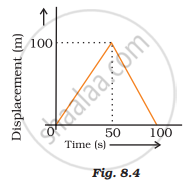Advertisements
Advertisements
प्रश्न
A bus decreases its speed from 80 km h−1 to 60 km h−1 in 5 s. Find the acceleration of the bus.
उत्तर
Initial velocity = 80km/h
= 80 × 100060 × 60
= 22.22 m/s
Time = 5s
Final velocity v = 60 km/h
= 60 × 100060 × 60
= 16.66 m/s
Acceleration =
=
=
= -1.11ms-2
Hence, acceleration of the bus = -1.11ms-2
APPEARS IN
संबंधित प्रश्न
Name the physical quantity whose SI unit is :
(a) m/s (b) m/s2
A boy is sitting on a merry-go-round which is moving with a constant speed of 10 m s−1. This means that the boy is :
A bicycle initially moving with a velocity 5.0 m s-1 accelerates for 5 s at a rate of 2 m s-2. What will be its final velocity?
State how the velocity-time graph can be used to find
The acceleration of a body
What do you understand by the term acceleration?
When is the negative acceleration?
A packet is dropped from a stationary helicopter, hovering at a height ‘h’ from ground level, reaches the ground in 12s. Calculate
- the value of h
- final velocity of packet on reaching the ground. (Take g = 9.8 ms−2)
How will the equations of motion for an object moving with a uniform velocity change?
A girl walks along a straight path to drop a letter in the letterbox and comes back to her initial position. Her displacement–time graph is shown in Fig.8.4. Plot a velocity-time graph for the same.

An electron moving with a velocity of 5 × 104 ms−1 enters into a uniform electric field and acquires a uniform acceleration of 104 ms–2 in the direction of its initial motion.
(i) Calculate the time in which the electron would acquire a velocity double of its initial velocity.
(ii) How much distance the electron would cover at this time?
